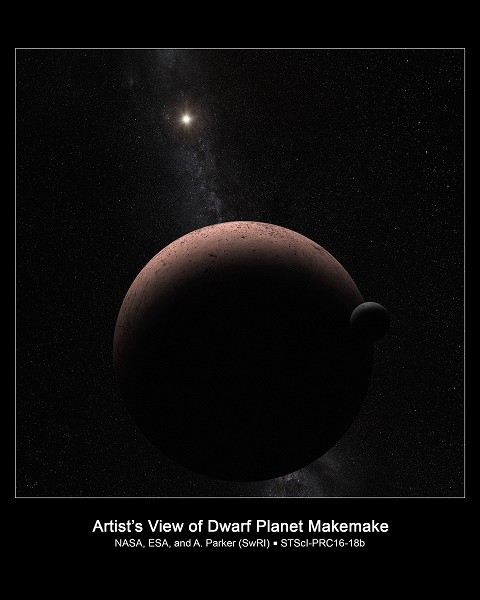By Ana Verayo, | April 27, 2016

This artist's concept shows the distant dwarf planet Makemake and its newly discovered moon. Makemake and its moon, nicknamed MK 2, are more than 50 times farther away than Earth is from the sun.
The dwarf planet MakeMake located is the third largest object in the Kuiper Belt after Pluto and Eris where astronomers discovered something astonishing lurking around this space rock, which is an orbiting moon.
Like Us on Facebook
Caltech astronomers Mike Brown and Chad Trujillo discovered the tiny world in 2005 where this new data from the Hubble Space Telescope confirms that MakeMake did have a natural satellite however, as to where it was hiding, scientists are still unsure about its current location.
According to principal investigator, Alex Parker who is a planetary scientist at the Southwest Research Institute, this moon was not faint and not that close to Makemake where it suddenly popped upon examining the data from Hubble.
Apparently, the moon has always been there which is now dubbed as MK 2, that orbits Makemake nearly on edge from the point of view from Earth, which means that it is most of the time obscured by the bright dwarf planet. Makemake is estimated to be 886 miles in diameter and this new object, is only estimated to be around 100 miles wide, which is also considered to be the darker companion of the brighter world.
MK 2's dark surface only reflects about four percent of light which can explain why scientists thought that Makemake had two contrasting albedos or reflective properties which suggest that these are caused by different materials. However, these dark spots did not coincide with Makemake's 7.7 hour-day.
Parker says that if this was indeed the case, Makemake's brightness would go up and down during rotation however, its brightness hardly fluctuates. Scientists now believe two theories that are working behind why Makemake is bright compared to its darker, mysterious moon.
This can be a captured object in the Kuiper Belt, getting reeled in by the forces of the asteroid belt and another theory could involve a collision, similar to Pluto's moon system.
If this moon originated from a collision, then MK2 would be covered in hydrocarbon film known as tholin that is seen as red patches on Pluto's moon, Charon. This hydrocarbon film would be emanating from Makemake due to a probable seasonal atmosphere where ice and other inherent chemicals on its surface sublimate or turn directly from solid to gas.
Astronomers will now conduct follow-up observations to pinpoint MK 2's orbit, which can prove to be challenging due to its orbit location. This will determine the size of the moon and mass of Makemake, joining other Kuiper Belt objects with moons such as Pluto, Eris, Quaoar, and Haumea.
-
Use of Coronavirus Pandemic Drones Raises Privacy Concerns: Drones Spread Fear, Local Officials Say

-
Coronavirus Hampers The Delivery Of Lockheed Martin F-35 Stealth Fighters For 2020

-
Instagram Speeds Up Plans to Add Account Memorialization Feature Due to COVID-19 Deaths

-
NASA: Perseverance Plans to Bring 'Mars Rock' to Earth in 2031

-
600 Dead And 3,000 In The Hospital as Iranians Believed Drinking High-Concentrations of Alcohol Can Cure The Coronavirus

-
600 Dead And 3,000 In The Hospital as Iranians Believed Drinking High-Concentrations of Alcohol Can Cure The Coronavirus

-
COVID-19: Doctors, Nurses Use Virtual Reality to Learn New Skills in Treating Coronavirus Patients







